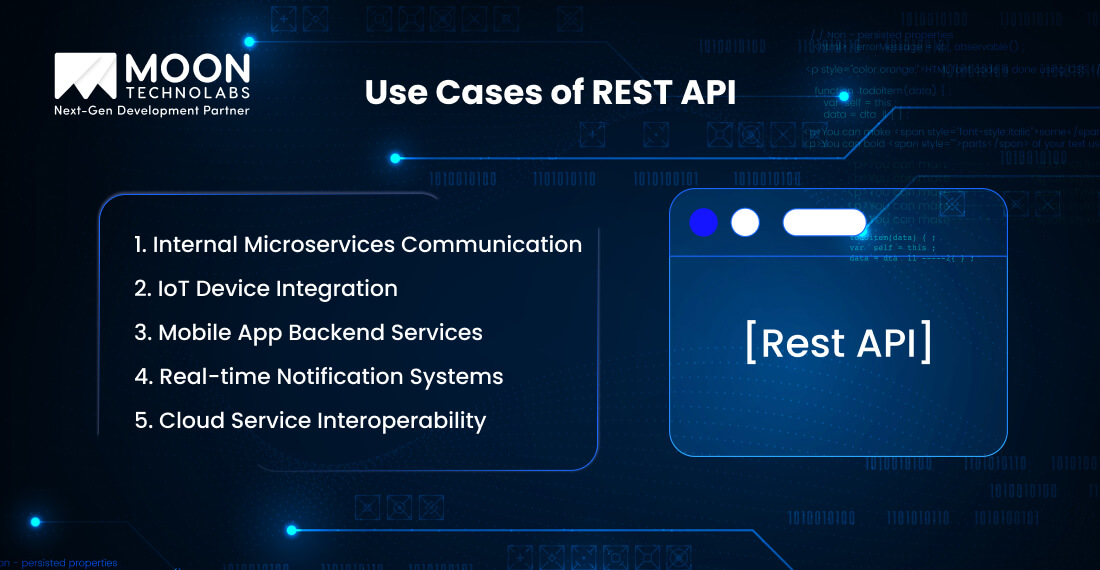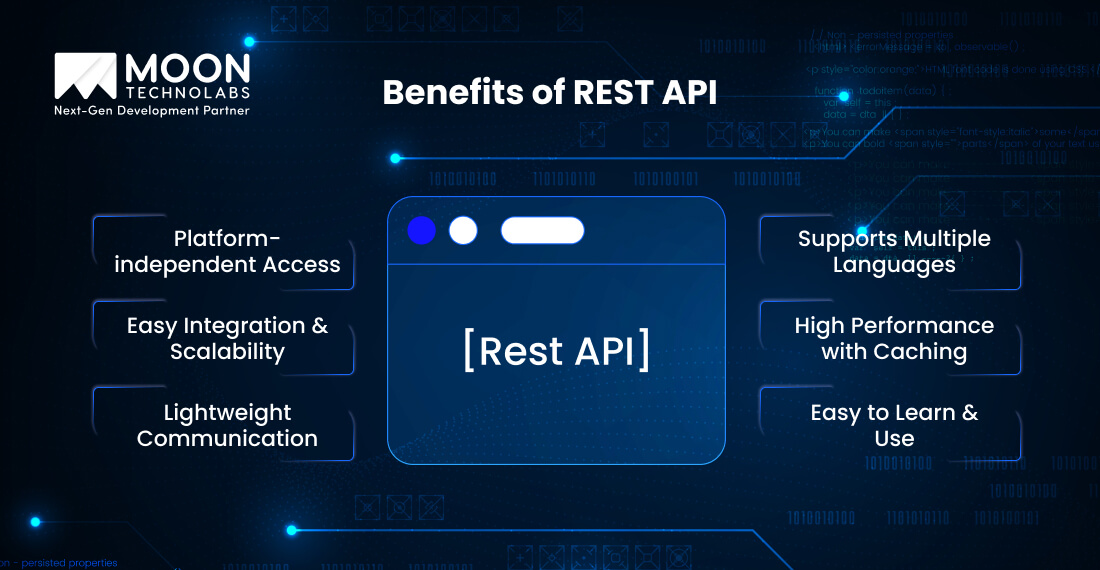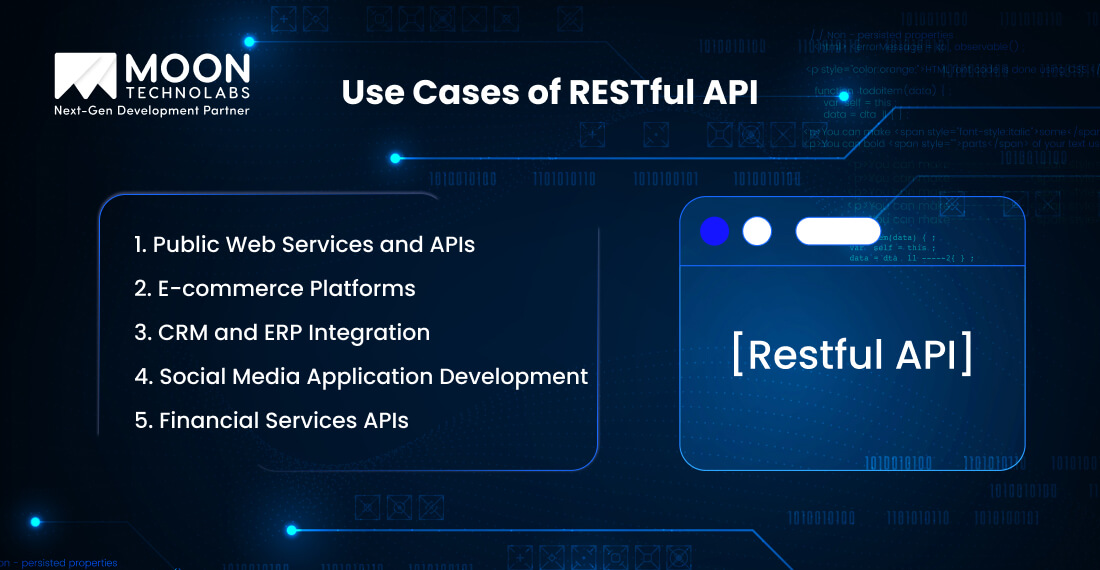Table of Content
Blog Summary:
Are you confused about REST and RESTful APIs? This blog breaks down their core differences, covering URI design, HTTP method usage, statelessness, response formatting, and compliance levels. It also explores practical use cases, key benefits, common misconceptions, and why JSON doesn’t equal RESTful. It’s the Ideal guide for developers and businesses looking to design efficient, scalable, and standards-compliant network applications.
Table of Content
APIs define how two software components should interact when designing web applications. Hence, APIs act as a bridge between the client and the server. Since communication across networks involves multiple clients, endpoints, and services, a proper architectural style is needed to structure it.
Representational state transfer (REST) is one of the most influential architectural styles, defining guidelines for structuring APIs. This is where the terms REST API and RESTful API enter the picture.
However, there’s growing confusion about both these terms. Are they similar? Do they follow different principles? Does it matter if the APIs are RESTful or not?
In this blog, we’ll explore the differences between Restful API vs REST API through their benefits, use cases, and common misconceptions.
Application programming interfaces (APIs) power the integration of different applications and systems. Whether you use apps like DoorDash or check your account balance from a banking application, APIs set the rules for how the various applications communicate with each other.
It specifies what a client can request, the type of response that they should expect from a server, and the rules that both the client & server sides must follow. APIs are essential for:
Let’s take an example of a weather app to understand how an API works:
Hence, API development is crucial for modular, scalable, and flexible web apps. Let’s move on to the most popular architectural style in web development, REST, and how it is designed and structured.
REST is an architectural style introduced by Roy Fielding. REST APIs implement the REST architecture style of web development. This style includes any API that adheres to the REST principles to structure client-server communication.
REST APIs allow applications to interact over the web using the HTTP protocol. HTTP methods help REST APIs perform operations on resources, providing a stateless, scalable, and maintainable client-server architecture.
In later sections, we’ll explain REST API in detail and provide a comprehensive comparison of REST API vs RESTful API.

REST APIs are widely adopted in numerous uses because they are simple, highly scalable, and closely aligned with web app architecture, working directly with HTTP. They are also easily built with any technology stack, encouraging clean and standardized design patterns.
Let’s understand some of the most common use cases of REST API:
An e-commerce website has separate microservices for user authentication, order tracking, and inventory management, each connected by a REST API for seamless data exchange.
A smart home thermostat sends temperature data every few minutes to a central server via a REST API, and the server sends back the configuration data.
A delivery app fetches listings with GET /restaurants and places orders with POST /Orders through REST API calls.
A project management app allows users to manage notification preferences, retrieve alerts, and mute channels with the REST API.
A SaaS platform utilizes REST APIs to integrate cloud email services such as SendGrid and CRMs such as Salesforce to track campaign engagement.
Tap into the lightweight and scalable REST APIs to build high-performing mobile backends and rapid integrations.

REST APIs are highly flexible, making them the most used API architecture among web developers. Since they can handle multiple requests, businesses can use them for website logins, integrate internal software, build dashboards, and even manage payment platforms.
Here are some other benefits of using them:
Since REST APIs are platform agnostic, a mobile app or even a Smart TV can communicate with the same backend API. It doesn’t need different logic for each client type.
REST APIs make it easier to add more servers to handle more requests. This allows systems to handle growing loads and be integrated with other services using a documented interface.
REST APIs communicate using lightweight formats such as JSON and XML. When combined with HTTP, requests and responses are made faster with minimum overhead.
REST API is supported across all programming languages and frameworks, from Python and Java to Ruby and PHP. It allows building clients and servers in any language and avoids locking in a specific stack.
With built-in HTTP features like caching and status codes, REST APIs reduce server loads and provide immediate feedback for efficient response handling.
REST APIs are highly intuitive, with standard HTTP methods such as POST, GET, etc., easier URL structures, and JSON formats, making them easy to learn for developers already familiar with web technologies.
A RESTful API strictly adheres to the REST principles while establishing the client-server relationship between web services. It is a more structured form of accessing resources and, hence, more standardized.
RESTful APIs are quite similar to REST APIs since they also use the same HTTP methods, are stateless, and have resource representations. However, the difference lies in accessing data across the web and in how they fetch, send, and format the data.
RESTful APIs are well-designed web services that allow access to resources using a clean and predictable structure since they are strictly REST-compliant. For example, GET /users/10 or POST /orders.
So while a REST API can exist without being RESTful, a RESTful API will always conform to the REST constraints.

We unpacked how RESTful APIs operate. It’s equally essential to understand where they truly shine in real-world applications. They have become the backbone of countless modern digital services across industries.
Let’s explore some of them:
RESTful APIs for public web services are common in applications that follow a predictable URI pattern. They utilize HTTP methods and enable search integration, authentication, and data access.
RESTful APIs in e-commerce platforms enable inventory management, pricing, orders, and carts across web and mobile apps.
In CRMs and ERPs, RESTful APIs enable connectivity between customer data, sales workflows, and inventory systems.
For social media application development, RESTful APIs help manage user content, likes, and followers. Resources like /users/ {id}/ followers offer predictability for third-party developers.
In banking and fintech apps, RESTful APIs function to gather account information, investment data, and financial transactions. Their statelessness makes them high-performing and secure with well-documented endpoints.

RESTful APIs are deeply embedded in the entire ecosystem of developing enterprise software. Hence, their widespread adoption is driven by many tangible benefits that make RESTful APIs a preferred choice for many businesses.
Let’s take a look at some of these benefits:
The URI structure of RESTful APIs is clean and resource-based, which helps improve the readability, consistency, and developers’ understanding of all the resources available.
Each request carries its context, which helps eliminate the need for the server to store session information. The statelessness simplifies server design and effortlessly supports horizontal scaling, making them ideal for high-performance systems.
RESTful APIs enhance security since they inherit HTTPS encryption and can use HTTP authentication schemes like JWT tokens and OAuth.
All operations, such as GET, POST, PUT, and DELETE, are directly mapped through resources, bringing uniformity and reducing ambiguity. Proper use of HTTP status codes assists in providing immediate feedback on a request’s success or failure.
RESTful APIs provide better support while handling versioning of URI paths and custom headers, making it easy to roll out updates.
Since RESTful APIs strictly follow REST guidelines, they have a consistent design across parameters and endpoints. This helps simplify documentation to build API-first apps with design tools like Swagger/OpenAPI for faster onboarding and efficient debugging due to predictable behavior.
Build apps with clean URIs, stateless operations, and easy versioning that are easily maintainable for the long term.
In the above sections, we have explained that although REST APIs and RESTful APIs may sound similar and can be used interchangeably, there are many subtle and crucial differences between them. Let’s understand these differences:
REST APIs: The interface of REST APIs is consistent, which helps simplify interactions and promote decoupling between the client and server. They also have a layered structure, with each layer having a specific function.
RESTful APIs: Their primary components include headers, data, methods, and endpoints. Together, these help manage data, manipulate information, and define the data location on the server.
REST APIs: Since they are more action-oriented, they might not follow consistent URI designs. This makes them resemble a more remote procedure call (RPC) than REST.
RESTful APIs: They follow resource-oriented URI designs strictly as they represent nouns and resources, not actions.
REST APIs: They might use HTTP methods inconsistently or incorrectly. In some cases, they also use POST for all action-oriented resources and data retrieval, which goes against REST principles.
RESTful APIs: They use standard HTTP methods such as GET, POST, PUT, PATCH, and DELETE to perform operations on resources.
REST APIs: They are stateless because the server doesn’t store any information about the client session. Hence, each client request to the server must contain all the information needed to understand and process the request.
RESTful APIs: Since they are strictly stateless, they always have independent requests. Each request contains all necessary information for processing, such as authentication tokens.
REST APIs: They have a resource-based structure since they treat data as resources. Each resource has a unique identification URI (Uniform Resource Identifier).
RESTful APIs: They treat everything as a resource, from users and products to orders and any other data entity, often identified as a URI. For example, GET /products/123 would signify fetching product details of ID 123.
REST APIs: Responses received from the server can be categorized into cacheable and non-cacheable. They represent resources in formats like JSON and XML, use HTTP status codes like 200, 400, and 404, and use hypermedia links to enable additional resources.
RESTful APIs: They commonly return a JSON or XML response and follow the hypertext application language (HAL) standard for consistency and structure.
REST APIs: They are looser implementations built as custom interfaces. This means that if a query or a call is placed for a specific function to get data, REST APIs won’t necessarily follow the REST principles.
RESTful APIs: They fully adhere to REST architectural constraints, making them truly stateless, cacheable, uniformly interfaced, and layered systems.
The biggest misconception about REST APIs and RESTful APIs is that any API working with HTTP protocols is RESTful because it uses HTTP methods. However, a truly RESTful API will strictly follow all the REST guidelines, going beyond just using HTTP methods.
Let’s understand some more of such misconceptions:
A REST API can be partially RESTful but not entirely. Being partly compliant with REST makes it a REST-like API, but not truly RESTful.
HTTP methods are fundamental in REST, no doubt, but they are not the only necessity. They should also be stateless and have a uniform interface.
RESTful APIs often use JSON formats along with XML for data exchange because they are readable and lightweight. However, REST is an architectural style that is format-independent, i.e., RESTful APIs can use any format.
RESTful APIs don’t always guarantee better performance. While they offer lightweight data transfer, their performance depends on how well they are designed and implemented.
Choosing between RESTful API and REST API requires you to identify the type of web service or application you aim to build. Here are some ideal use cases for each of them:
Choose REST APIs when:
Why: They have an architecture that involves developing and deploying independent services.
Why: They work as a bridge for data exchange while analyzing, reporting, and alerting.
Why: They allow them to store and fetch data, establish server-side logic, and manage authentication.
Why: REST APIs help in managing notification rules, history logs, and subscriptions.
Choose RESTful APIs when:
Why: Their URI structure and HTTP standards make it easy to document.
Why: Since they are stateless, they are highly scalable during high traffic
Why: Since they have clean URI designs and stateless calls, it’s easier and faster to integrate them without being tightly coupled
Why: They are lightweight, cacheable, and platform-independent across iOS and Android platforms, making communication easier.
For businesses aiming to build scalable, secure, and maintainable web applications, choosing between REST APIs and RESTful APIs can be the deciding factor. The right API architecture can help them streamline operations, launch new digital products, or integrate with third-party platforms.
If your business wants to improve the performance of its web applications and provide a better user experience, it needs the right API development partner.
At Moon Technolabs, our expert developers have deep expertise in building REST and RESTful APIs. We ensure that your applications are optimized for speed and scalability. Let us help you bridge the gap between your business goals and the right technical foundation.
Book a FREE consultation with our experts.
01
02
03
04
05
Submitting the form below will ensure a prompt response from us.